Battle for Zendikar brings back many familiar elements from the original Zendikar Block, and appears designed to mimic the popular limited format of triple Rise of the Eldrazi draft. There are huge expensive creatures, a variety of somewhat expensive ramp spells, “invokers” to act as mana sinks, and so forth.
This is a bad sign for the set’s chances to make a splash in the eternal constructed formats. Because of format speed and the presence of Wasteland/Daze decks, the cutoff line for playable cards in Legacy typically stops at 4 — and it better darn well win you the game at that price. In both Vintage and Legacy there exist powerful spells to cheat expensive creatures into play. But unless the new creature is better than Griselbrand or Emrakul, the Aeons Torn, it will never be more than a niche option.
The cards I’ve chosen for this review all have some potential to see play under the right format conditions, but nothing from this set appears to be an instant homerun along the lines of Monastery Mentor and last year’s delve draw spells. Nevertheless, I was able to find several cards with some promise in older formats.
Combined with Knight of the Reliquary, this card will allow you to thin your deck of every Plains, Forest, and fetchland capable of getting those types. For each fetchland you grab with KotR’s ability, you’ll get an extra trigger allowing you to convert one of your other Plains or Forest in play into anything you like. At the end of the chain, you’ll also be able to grab whatever special land you like. Along the way, you are generating a ton of mana, the Knight herself will grow quite large, and you’ll end up with a Mana Severanced deck and a ton of graveyard fuel if you have any way to abuse that.
You could end the chain with Sejiri Steppe to give your Knight protection and swing past any blockers, or grab Kessig Wolf Run for the trample damage if you managed to grab some red mana during the combo. You could also add in other landfall creatures to take advantage of the couple-dozen triggers you’d be generating, but I think that adding another piece to this combo isn’t the way you’d want to go.
Is there a home for this interaction somewhere? Well, KotR hasn’t seen much Legacy play since Maverick disappeared from the format. There were Bant-colored Knight decks in the format as recently as 2011, but like most midrange strategies in Legacy they have been firmly pushed out by Delver and combo.
The commonly-asked question about any combo piece is, “Does this do anything when I don’t have the other part?” KotR, despite her recent lack of success, is definitely a powerful card with a Legacy pedigree, so no question there. Retreat to Coralhelm’s landfall abilities, without the Knight in play, do provide some real value even though the card would never be played on its own merits. The most powerful creature in Legacy with a tap ability is Deathrite Shaman, which you would almost certainly play in this deck, and getting a second DRS activation per turn is extremely good. If you have no other creatures with tap abilities to re-use, you will get to scry 1 after fetching a land.
I think this interaction is powerful, and gives a midrange Bant deck a different angle of attack. But it doesn’t really fix the problems that have kept this type of deck out of Legacy. If at some point the format adjusts to where a Bant midrange deck was powerful again, I could imagine adding a couple copies of Retreat in the 75, as the card works well with the things you’d already be playing. Until then, this combo doesn’t really have a home.
Manlands! There is going to be an entire cycle of enemy-colored manlands in this block, and that is definitely an eternal-playable card type. Mishra’s Factory has been a staple of the Vintage format since the earliest days of Magic. Being able to turn your free land drops into something more useful later in the game has enormous value in general, and is the backbone of the Standstill-based “Landstill” control archetype. Over the years, Mutavault and Creeping Tar Pit have both seen play in decks ranging from tribal to control.
Creeping Tar Pit is instructive here. Because Tar Pit has seen Legacy play, we know that 3 mana is an acceptable activation cost. That threshold has not been crossed, but we cannot know for certain whether or not Raging Ravine might have been played if it were in better colors.
Blue-green is a popular combination in both Legacy and Vintage. The ability here is excellent as well. Your opponent will be able to kill this while it’s a land, most commonly with Wasteland, but all types of removal are blanked when it has hexproof.
Yet this is a very slow clock. The primary purpose of Tar Pits in Legacy is not to act as control finishers, but rather to sneak past the line to threaten opposing planeswalkers. This was particularly valuable during the heyday of Jace, the Mind Sculptor. But even now, the stock Shardless BUG list contains one or two copies. These decks play Deathrite Shaman, thus having the mana to activate the ability is a reasonable expectation.
My prediction is that this could show up in a couple of Top 8′s from Legacy BUG players experimenting with it. It’s conveniently already in their colors, after all. I think the hexproof will be less valuable in the current format than the unblockability Tar Pit gives you at a cheaper activation cost, and Tar Pit is already immune to the most commonly played removal spell in Abrupt Decay just by virtue of being a land. Even against Miracles, where Lumbering Falls’ immunity to Swords to Plowshares weighs in its favor, there is often a stray Snapcaster Mage around to block for that Jace you want to kill.
The “devoid” mechanic is a strange one. There doesn’t seem to be much in the set to make use of it outside of some minor synergies for having colorless creatures. But there are a few spots in Legacy and Modern where having colorless removal could be useful.
Complete Disregard is a reasonably flexible removal spell, killing any commonly-played Legacy creature with the exception of Tarmogoyf and the delve creatures like Tasigur, the Golden Fang or Gurmag Angler. But 3 mana would be too much to pay for even unconditional removal in that format, even with the minor upside of exiling. For this reason, the card will see play only if it is the best answer to a particularly troublesome creature that black couldn’t otherwise handle.
Either one or two copies of Mirran Crusader are commonly included in the stock lists for Death and Taxes. BUG decks often have no good way to deal with the Crusader, as they consist entirely of black removal spells and black or green creatures. Toxic Deluge will help, but also sweeps away your own small creatures such as DRS or Baleful Strix in the process. Unfortunately, Death and Taxes is the type of deck that can make it very difficult for an opponent to cast 3-mana noncreature spells. On the upside, it is an instant and you could cast it on upkeep even while facing down a couple of Rishadan Port, which cannot be said for Toxic Deluge. My gut instinct here is that this is too narrow. Deluge might have its drawbacks, but it absolutely wrecks D&T if you get it off, while also being strong against Elves or whatever random tribal aggro deck you could face in the early rounds of a large tournament.
In Modern, where Deluge is unavailable, this seems to be a fine answer to Etched Champion. EC is a common sideboard plan for affinity against the Modern format’s many BGx decks. Many such decks have few to no answers for an EC with metalcraft. There is, of course, the problem of Cranial Plating. If they get the EC suited up with Plating, Complete Disregard would no longer be able to target it. Destroying a Plating is much easier than destroying the EC itself, but if you’re bringing something in to deal with one particular card you probably want to be sure that it reliably answers that threat. It’s also worth noting that black is nearly always paired with green in Modern, so any deck that could cast this could also cast Creeping Corrosion for one additional mana. When affinity is on the Etched Champion plan, they are not playing a particularly explosive game, so you will probably have the time to cast Corrosion instead.
Wasteland Strangler is the Flametongue Kavu of the devoid creature lineup. -3/-3 will kill a lot of creatures, including the threats we’ve just discussed. The trick is finding some way to turn that ability on by first having something in the opponent’s exile zone. In Legacy, your opponent might do this for you in any number of ways, such as with an early Force of Will pitching a blue card, or with a DRS exiling a land. You might also help your cause by packing Swords to Plowshares. Ordinarily if a card relies on some specific condition happening, I would say you want a dozen ways in your own deck to make sure it works. But most games of Legacy end up with cards in the exile zone pretty naturally.
I think Wasteland Strangler is a very cool card, but is probably too much work for Legacy, where even FTK hasn’t seen play in years. The power level is actually a bit worse in Modern, since there are fewer ways that cards naturally end up in the exile zone. The interaction with something like Journey to Nowhere or Flickerwisp is cute, but not powerful enough to persuade me to play those cards.
This is the same effect as Blood Artist but with a few small differences. On the downside, it doesn’t trigger off opposing creatures’ deaths. On the plus side, it doesn’t target, so it gets around Leyline of Sanctity effects. It is also a Human, which is usually a better creature type than Vampire if Cavern of Souls is part of your plan. Finally, this is fairly trivial, but Cutthroat does have a point of power.
So if you have a Modern deck built around Blood Artist and find these to be upgrades, you would make the switch. Personally, I like that the opponent loses life off his own creatures’ deaths to Blood Artist, as it makes combat more difficult for him, and I’m yet to have anybody board in Leyline against me while playing Blood Artist.
As a quasi-scalable Pyroclasm effect at a reasonable cost, this could potentially see some play. It’s being compared unfavorably to Anger of the Gods by Standard players, but not costing double-red is a bonus in older formats. The main advantage I see here is the ability to turn this into a one-sided wrath in certain matchups. In Modern, a Zoo deck could cast this for 2 to wipe an affinity player’s board while keeping his Wild Nacatls and Kird Apes alive. Urzatron decks will stick to Pyroclasm or Firespout since they rarely go for a second colored source early.
This is an easier-to-cast upgrade of a spell that already sees play: Sowing Salt. As such, I am 100% confident this will be played. At the moment, I see no upside or downside to the colorless nature of the spell, though it’s possible the designers have something planned for the spring set to give the devoid mechanic some impact. Until then, this is a strict upgrade.
I doubt this will see play, but because Dark Petition has caught on, I won’t rule it out. Like DP, this both tutors and gives you mana by allowing the card to be cast for free. And it’s blue, so you can pitch it to Force! But the comparison goes downhill from there. The decks that would want this can probably make green, but getting to 5 mana and still having a green mana available is a bit of an awkward sequence for most ritual based combo decks. Dark Petition can grab Ad Nauseam, but as a practical matter you won’t be able to do that with Bring to Light.
Finally, we end with the big bad Eldrazi Titan, Ulamog II. For one mana less than Ulamog, the Infinite Gyre, you actually get a big upgrade on the cast-trigger. Exiling two permanents wins handily over destroying a single permanent. Both have indestructible. Ulamog the First definitely has the more threatening attack-trigger. Your opponent will in most cases effectively lose the game if he has to sacrifice four permanents. Exiling twenty cards from the library will take three swings to kill an opponent.
I expect 12-Post players to at least experiment with this, as there will be situations where the opponent has laid down a second Ensnaring Bridge and you need to zap both of them. The 1-mana discount will be relevant, too, even with a deck that generates stupid amounts of mana. Right now, a single copy of original Ulamog is stock in 12-Post lists. It’s possible this Ulamog takes over the slot going forward on the strength of that double-exiling trigger.

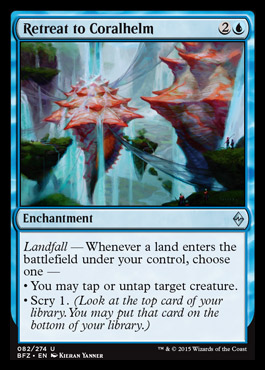
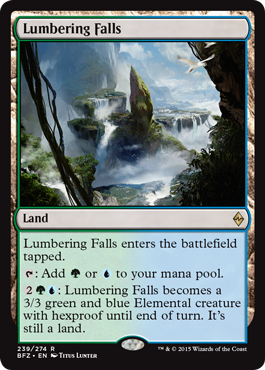
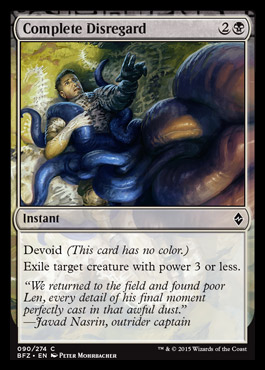
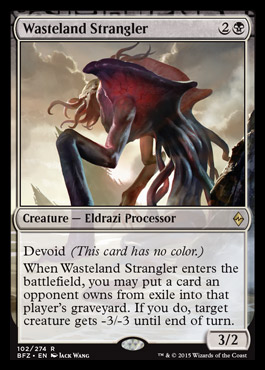

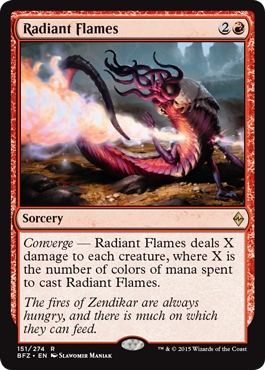
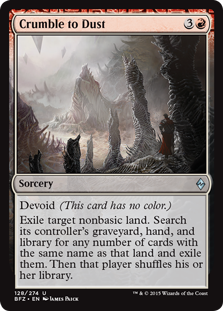

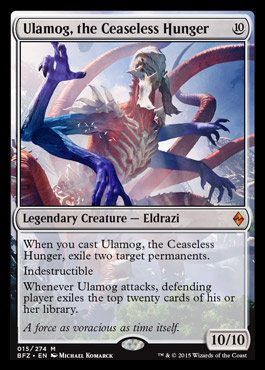
Tidehollow Sculler is the card that just might make Wasteland Strangler playable in Modern
But is it that big of an upgrade over Skinrender? That always triggers, too. Either way, you’re going to have the wrong card in some niche scenarios, but usually Skinrender will be more reliable.
Well, Skinrender showed up in very early Modern Pod lists (like circa 2012) and then once in a blue moon it pops up as a one-of in a G/B/x sideboard. Getting a borderline-playable effect at a mana cheaper with some restriction or condition is often the type of thing that winds up producing an eternal playable, so I figured it was worth exploring. If a playset of Siege Rhino is your top-curve creature, as it is in Abzan Rock decks for example, you won’t have much more room for dudes that expensive in your build, but getting a 2-for-1 with your 3-drop might be very attractive if you can swing it.
I think a bigger problem is the Grixis deck can already out-grind G/B/x decks and this guy’s 3/2 body only trades with their Snapcasters in combat, but when I do a set review for eternal I have to take into account that the existing metagame quirks will be different X number of weeks/months from now.
I’m more excited about Zulaport Cutthroat as Blood Artists 5 to (potentially) 8 than as replacements. I don’t know precisely how much of a benefit Blood Artist decks get from the extra consistency on that axis, but it seems worth exploring.
I’ve also heard suggestions for Bring to Light bringing Eggs back into Modern, by returning the redundancy to Faith’s Reward that was lost when Sunrise was banned. Again, not sure if it’s enough to do it, but it is a mana cheaper than Open the Vaults.